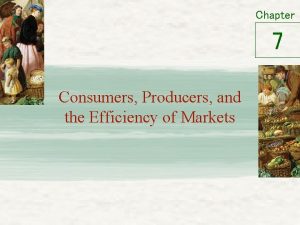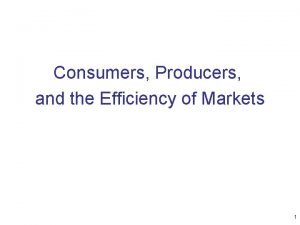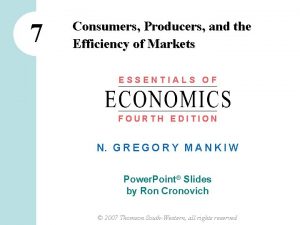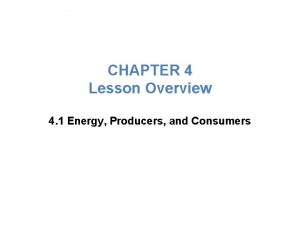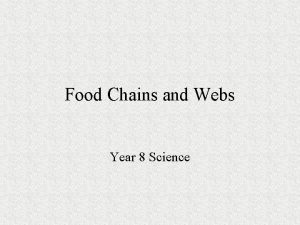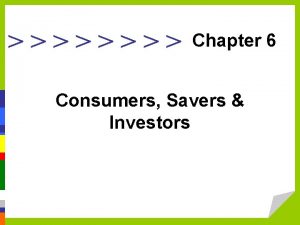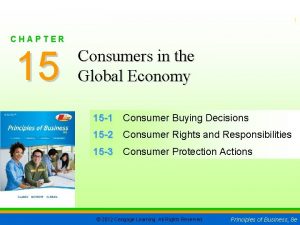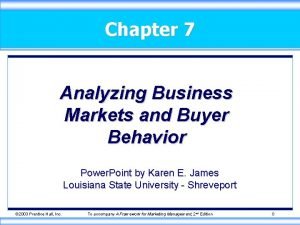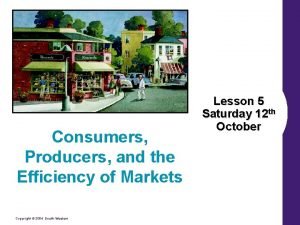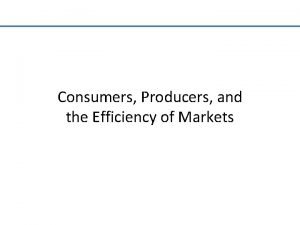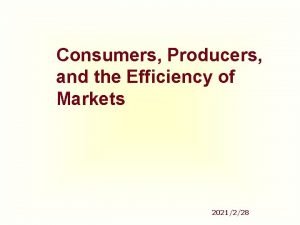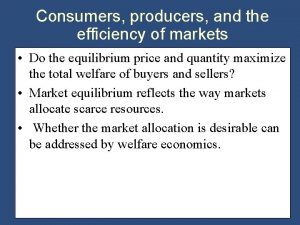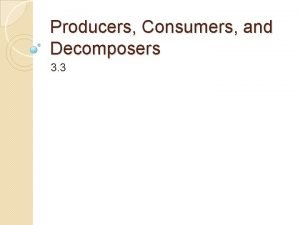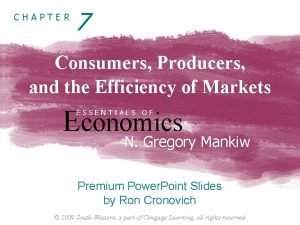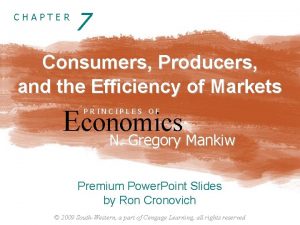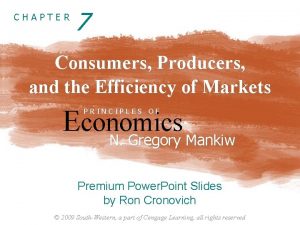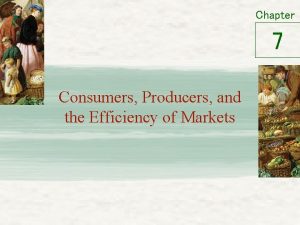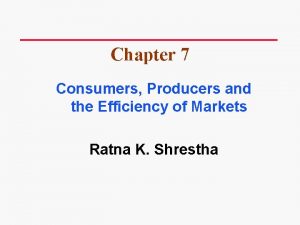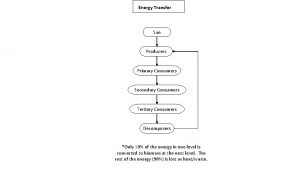Consumers Producers and the Efficiency of Markets Chapter





















































- Slides: 53

Consumers, Producers, and the Efficiency of Markets Chapter 7 Copyright © 2001 by Harcourt, Inc. All rights reserved. Requests for permission to make copies of any part of the work should be mailed to: Permissions Department, Harcourt College Publishers, 6277 Sea Harbor Drive, Orlando, Florida 32887 -6777.

Revisiting the Market Equilibrium Do the equilibrium price and quantity maximize the total welfare of buyers and sellers? Market equilibrium reflects the way markets allocate scarce resources. u Whether the market allocation is desirable is determined by welfare economics. u Harcourt, Inc. items and derived items copyright © 2001 by Harcourt, Inc.

Welfare Economics Welfare economics is the study of how the allocation of resources affects economic well-being. u Buyers and sellers receive benefits from taking part in the market. u The equilibrium in a market maximizes the total welfare of buyers and sellers. Harcourt, Inc. items and derived items copyright © 2001 by Harcourt, Inc.

Welfare Economics Equilibrium in the market results in maximum benefits, and therefore maximum total welfare for both the consumers and the producers of the product. Harcourt, Inc. items and derived items copyright © 2001 by Harcourt, Inc.

Welfare Economics u. Consumer surplus measures economic welfare from the buyer’s side. u. Producer surplus measures economic welfare from the seller’s side. Harcourt, Inc. items and derived items copyright © 2001 by Harcourt, Inc.

Consumer Surplus u. Willingness to pay is the maximum price that a buyer is willing and able to pay for a good. u. It measures how much the buyer values the good or service. Harcourt, Inc. items and derived items copyright © 2001 by Harcourt, Inc.

Consumer Surplus Consumer surplus is the amount a buyer is willing to pay for a good minus the amount the buyer actually pays for it. Harcourt, Inc. items and derived items copyright © 2001 by Harcourt, Inc.

Four Possible Buyers’ Willingness to Pay. . . Harcourt, Inc. items and derived items copyright © 2001 by Harcourt, Inc.

Consumer Surplus The market demand curve depicts the various quantities that buyers would be willing and able to purchase at different prices. Harcourt, Inc. items and derived items copyright © 2001 by Harcourt, Inc.

Four Possible Buyers’ Willingness to Pay. . . Harcourt, Inc. items and derived items copyright © 2001 by Harcourt, Inc.

Measuring Consumer Surplus with the Demand Curve. . . Price of Album John’s willingness to pay $100 Paul’s willingness to pay 80 70 George’s willingness to pay Ringo’s willingness to pay 50 Demand 0 1 2 3 Harcourt, Inc. items and derived items copyright © 2001 by Harcourt, Inc. 4 Quantity of Albums

Measuring Consumer Surplus with the Demand Curve. . . Price of Album Price = $80 $100 John’s consumer surplus ($20) 80 70 50 Demand 0 1 2 3 Harcourt, Inc. items and derived items copyright © 2001 by Harcourt, Inc. 4 Quantity of Albums

Measuring Consumer Surplus with the Demand Curve. . . Price of Album Price = $70 $100 John’s consumer surplus ($30) 80 70 50 Paul’s consumer surplus ($10) Total consumer surplus ($40) Demand 0 1 2 3 Harcourt, Inc. items and derived items copyright © 2001 by Harcourt, Inc. 4 Quantity of Albums

Measuring Consumer Surplus with the Demand Curve The area below the demand curve and above the price measures the consumer surplus in the market. Harcourt, Inc. items and derived items copyright © 2001 by Harcourt, Inc.

Copyright © 2001 by Harcourt, Inc. All rights reserved How the Price Affects Consumer Surplus. . . Price A P 1 P 2 Initial consumer surplus B D Additional consumer surplus to initial consumers 0 Consumer surplus to new consumers C E F Demand Q 1 Q 2 Quantity

Consumer Surplus and Economic Well-Being Consumer surplus, the amount that buyers are willing to pay for a good minus the amount they actually pay for it, measures the benefit that buyers receive from a good as the buyers themselves perceive it. Harcourt, Inc. items and derived items copyright © 2001 by Harcourt, Inc.

Producer Surplus u. Producer surplus is the amount a seller is paid minus the cost of production. u. It measures the benefit to sellers participating in a market. Harcourt, Inc. items and derived items copyright © 2001 by Harcourt, Inc.

The Costs of Four Possible Sellers. . . Harcourt, Inc. items and derived items copyright © 2001 by Harcourt, Inc.

Producer Surplus and the Supply Curve u Just as consumer surplus is related to the demand curve, producer surplus is closely related to the supply curve. u At any quantity, the price given by the supply curve shows the cost of the marginal seller, the seller who would leave the market first if the price were any lower. Harcourt, Inc. items and derived items copyright © 2001 by Harcourt, Inc.

Supply Schedule for the Four Possible Sellers. . . Harcourt, Inc. items and derived items copyright © 2001 by Harcourt, Inc.

Producer Surplus and the Supply Curve. . . Price of House Painting Supply Mary’s cost Frida’s cost $900 800 Georgia’s cost Grandma’s cost 600 500 0 1 2 Harcourt, Inc. items and derived items copyright © 2001 by Harcourt, Inc. 3 4 Quantity of Houses Painted

Producer Surplus and the Supply Curve The area below the price and above the supply curve measures the producer surplus in a market. Harcourt, Inc. items and derived items copyright © 2001 by Harcourt, Inc.

Measuring Producer Surplus with the Supply Curve. . . Price of House Painting Price = $600 Supply $900 800 600 500 Grandma’s producer surplus ($100) 0 1 2 Harcourt, Inc. items and derived items copyright © 2001 by Harcourt, Inc. 3 4 Quantity of Houses Painted

Measuring Producer Surplus with the Supply Curve. . . Price of House Painting Price = $800 $900 Supply Total producer surplus ($500) 800 Georgia’s producer surplus ($200) 600 500 Grandma’s producer surplus ($300) 0 1 2 Harcourt, Inc. items and derived items copyright © 2001 by Harcourt, Inc. 3 4 Quantity of Houses Painted

How Price Affects Producer Surplus. . . Price Supply Additional producer surplus to initial producers P 2 D P 1 B Initial Producer surplus E F C Producer surplus to new producers A 0 Q 1 Harcourt, Inc. items and derived items copyright © 2001 by Harcourt, Inc. Q 2 Quantity

Market Efficiency Consumer surplus and producer surplus may be used to address the following question: Is the allocation of resources determined by free markets in any way desirable? Harcourt, Inc. items and derived items copyright © 2001 by Harcourt, Inc.

Economic Well-Being and Total Surplus Consumer Surplus = Value to _ Amount paid buyers by buyers and Producer Surplus = Amount received _ Cost to by sellers Harcourt, Inc. items and derived items copyright © 2001 by Harcourt, Inc.

Economic Well-Being and Total Surplus = Consumer Surplus + Producer Surplus or Total Surplus = Value to _ Cost to buyers sellers Harcourt, Inc. items and derived items copyright © 2001 by Harcourt, Inc.

Market Efficiency Market efficiency is achieved when the allocation of resources maximizes total surplus. Harcourt, Inc. items and derived items copyright © 2001 by Harcourt, Inc.

Market Efficiency In addition to market efficiency, a social planner might also care about equity – the fairness of the distribution of well-being among the various buyers and sellers. Harcourt, Inc. items and derived items copyright © 2001 by Harcourt, Inc.

Evaluating the Market Equilibrium. . . Price A D Equilibrium price Supply E B Demand C 0 Equilibrium quantity Harcourt, Inc. items and derived items copyright © 2001 by Harcourt, Inc. Quantity

Consumer and Producer Surplus in the Market Equilibrium. . . Price A D Equilibrium price Supply Consumer surplus E Producer surplus B Demand C 0 Equilibrium quantity Harcourt, Inc. items and derived items copyright © 2001 by Harcourt, Inc. Quantity

Three Insights Concerning Market Outcomes u Free markets allocate the supply of goods to the buyers who value them most highly. u Free markets allocate the demand for goods to the sellers who can produce them at least cost. u Free markets produce the quantity of goods that maximizes the sum of consumer and producer surplus. Harcourt, Inc. items and derived items copyright © 2001 by Harcourt, Inc.

The Efficiency of the Equilibrium Quantity Price Supply Value to buyers Cost to sellers 0 Value to buyers Demand Equilibrium quantity Value to buyers is greater than cost to sellers. Harcourt, Inc. items and derived items copyright © 2001 by Harcourt, Inc. Value to buyers is less than cost to sellers. Quantity

The Efficiency of the Equilibrium Quantity u. Because the equilibrium outcome is an efficient allocation of resources, the social planner can leave the market outcome as he/she finds it. u. This policy of leaving well enough alone goes by the French expression laissez faire. Harcourt, Inc. items and derived items copyright © 2001 by Harcourt, Inc.

Market Power u If a market system is not perfectly competitive, market power may result. u Market power is the ability to influence prices. u Market power can cause markets to be inefficient because it keeps price and quantity from the equilibrium of supply and demand. Harcourt, Inc. items and derived items copyright © 2001 by Harcourt, Inc.

Externalities are created when a market outcome affects individuals other than buyers and sellers in that market. u. Externalities cause welfare in a market to depend on more than just the value to the buyers and cost to the sellers. u. When buyers and sellers do not take externalities into account when deciding how much to consume and produce, the equilibrium in the market can be inefficient. Harcourt, Inc. items and derived items copyright © 2001 by Harcourt, Inc.

Summary u. Consumer surplus measures the benefit buyers get from participating in a market. u. Consumer surplus can be computed by finding the area below the demand curve and above the price. Harcourt, Inc. items and derived items copyright © 2001 by Harcourt, Inc.

Summary u. Producer surplus measures the benefit sellers get from participating in a market. u. Producer surplus can be computed by finding the area below the price and above the supply curve. Harcourt, Inc. items and derived items copyright © 2001 by Harcourt, Inc.

Summary u The equilibrium of demand supply maximizes the sum of consumer and producer surplus. u This is as if the invisible hand of the marketplace leads buyers and sellers to allocate resources efficiently. u Markets do not allocate resources efficiently in the presence of market failures. Harcourt, Inc. items and derived items copyright © 2001 by Harcourt, Inc.

Summary u An allocation of resources that maximizes the sum of consumer and producer surplus is said to be efficient. u Policymakers are often concerned with the efficiency, as well as the equity, of economic outcomes. Harcourt, Inc. items and derived items copyright © 2001 by Harcourt, Inc.

Graphical Review Harcourt, Inc. items and derived items copyright © 2001 by Harcourt, Inc.

Measuring Consumer Surplus with the Demand Curve. . . Price of Album John’s willingness to pay $100 Paul’s willingness to pay 80 70 George’s willingness to pay Ringo’s willingness to pay 50 Demand 0 1 2 3 Harcourt, Inc. items and derived items copyright © 2001 by Harcourt, Inc. 4 Quantity of Albums

Measuring Consumer Surplus with the Demand Curve. . . Price of Album Price = $80 $100 John’s consumer surplus ($20) 80 70 50 Demand 0 1 2 3 Harcourt, Inc. items and derived items copyright © 2001 by Harcourt, Inc. 4 Quantity of Albums

Measuring Consumer Surplus with the Demand Curve. . . Price of Album Price = $70 $100 John’s consumer surplus ($30) 80 70 50 Paul’s consumer surplus ($10) Total consumer surplus ($40) Demand 0 1 2 3 Harcourt, Inc. items and derived items copyright © 2001 by Harcourt, Inc. 4 Quantity of Albums

Copyright © 2001 by Harcourt, Inc. All rights reserved How the Price Affects Consumer Surplus. . . Price A P 1 P 2 Initial consumer surplus B D Additional consumer surplus to initial consumers 0 Consumer surplus to new consumers C E F Demand Q 1 Q 2 Quantity

Producer Surplus and the Supply Curve. . . Price of House Painting Supply Mary’s cost $900 Frida’s cost 800 Georgia’s cost Grandma’s cost 600 500 0 1 2 Harcourt, Inc. items and derived items copyright © 2001 by Harcourt, Inc. 3 4 Quantity of Houses Painted

Measuring Producer Surplus with the Supply Curve. . . Price of House Painting Price = $600 Supply $900 800 600 500 Grandma’s producer surplus ($100) 0 1 2 Harcourt, Inc. items and derived items copyright © 2001 by Harcourt, Inc. 3 4 Quantity of Houses Painted

Measuring Producer Surplus with the Supply Curve. . . Price of House Painting Price = $800 $900 Supply Total producer surplus ($500) 800 Georgia’s producer surplus ($200) 600 500 Grandma’s producer surplus ($300) 0 1 2 Harcourt, Inc. items and derived items copyright © 2001 by Harcourt, Inc. 3 4 Quantity of Houses Painted

How Price Affects Producer Surplus. . . Price Supply Additional producer surplus to initial producers P 2 D P 1 B Initial Producer surplus E F C Producer surplus to new producers A 0 Q 1 Harcourt, Inc. items and derived items copyright © 2001 by Harcourt, Inc. Q 2 Quantity

Evaluating the Market Equilibrium. . . Price A D Equilibrium price Supply E B Demand C 0 Equilibrium quantity Harcourt, Inc. items and derived items copyright © 2001 by Harcourt, Inc. Quantity

Consumer and Producer Surplus in the Market Equilibrium. . . Price A D Equilibrium price Supply Consumer surplus E Producer surplus B Demand C 0 Equilibrium quantity Harcourt, Inc. items and derived items copyright © 2001 by Harcourt, Inc. Quantity

The Efficiency of the Equilibrium Quantity Price Supply Value to buyers Cost to sellers 0 Value to buyers Demand Equilibrium quantity Value to buyers is greater than cost to sellers. Harcourt, Inc. items and derived items copyright © 2001 by Harcourt, Inc. Value to buyers is less than cost to sellers. Quantity
 Chapter 7 consumers producers and the efficiency of markets
Chapter 7 consumers producers and the efficiency of markets Consumers, producers, and the efficiency of markets
Consumers, producers, and the efficiency of markets Consumers producers and the efficiency of markets
Consumers producers and the efficiency of markets Primary consumer secondary consumer and tertiary consumer
Primary consumer secondary consumer and tertiary consumer Primary producers
Primary producers Chapter 4 lesson 1 energy, producers and consumers
Chapter 4 lesson 1 energy, producers and consumers Are producers decomposers
Are producers decomposers Producers, consumers, decomposers
Producers, consumers, decomposers Consumer decomposer producer
Consumer decomposer producer Are producers decomposers
Are producers decomposers What are decomposers in a food web
What are decomposers in a food web Food web
Food web Energy producers and consumers lesson 1
Energy producers and consumers lesson 1 Decomposer
Decomposer Rainforest food chains for kids
Rainforest food chains for kids Producers
Producers Producer in food chain
Producer in food chain Consumers in the tropical rainforest
Consumers in the tropical rainforest Producers food chain
Producers food chain Organizational buyer
Organizational buyer Producers consumers decomposers
Producers consumers decomposers Biotic components producers consumers decomposers
Biotic components producers consumers decomposers Producers respond to consumers' positive economic votes by
Producers respond to consumers' positive economic votes by Mono lake food web answers
Mono lake food web answers Creating products for consumers in global markets
Creating products for consumers in global markets Allocative efficiency vs productive efficiency
Allocative efficiency vs productive efficiency Allocative efficiency vs productive efficiency
Allocative efficiency vs productive efficiency Productive inefficiency and allocative inefficiency
Productive inefficiency and allocative inefficiency Chapter 6 consumers savers and investors
Chapter 6 consumers savers and investors Why study financial markets and institutions
Why study financial markets and institutions Characteristics of consumer behaviour
Characteristics of consumer behaviour Chapter 9 expanding markets and moving west
Chapter 9 expanding markets and moving west Business buyer definition
Business buyer definition Chapter 5 consumer markets and buyer behavior
Chapter 5 consumer markets and buyer behavior Chapter 5 consumer markets and buyer behavior
Chapter 5 consumer markets and buyer behavior Chapter 9 expanding markets and moving west
Chapter 9 expanding markets and moving west Chapter 9 expanding markets and moving west
Chapter 9 expanding markets and moving west Chapter 15 consumers in the global economy
Chapter 15 consumers in the global economy Chapter 28 role of consumers in a market economy
Chapter 28 role of consumers in a market economy Cultural dynamics in assessing global markets
Cultural dynamics in assessing global markets Analyzing consumer and business markets
Analyzing consumer and business markets Chapter 18 the markets for the factors of production
Chapter 18 the markets for the factors of production Analyzing consumer markets
Analyzing consumer markets Firms in competitive markets chapter 14 ppt
Firms in competitive markets chapter 14 ppt Rabbits food chain
Rabbits food chain Algae and many bacteria are primary producers
Algae and many bacteria are primary producers Hát kết hợp bộ gõ cơ thể
Hát kết hợp bộ gõ cơ thể Bổ thể
Bổ thể Tỉ lệ cơ thể trẻ em
Tỉ lệ cơ thể trẻ em Chó sói
Chó sói Tư thế worm breton là gì
Tư thế worm breton là gì Chúa sống lại
Chúa sống lại Các môn thể thao bắt đầu bằng tiếng bóng
Các môn thể thao bắt đầu bằng tiếng bóng
